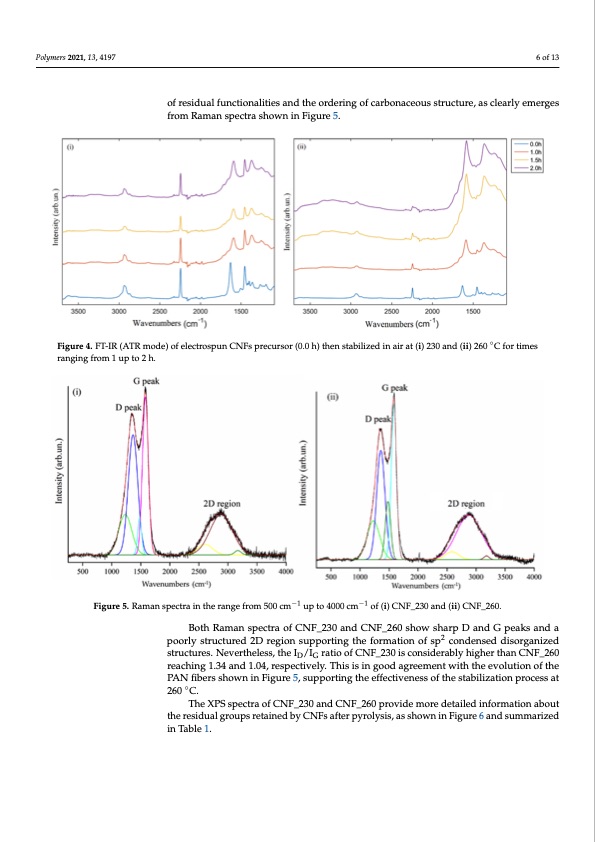
PDF Publication Title:
Text from PDF Page: 006
a in air, the PAN structure could undergo several modifications due to the oxidation and rearrangement of nitrile groups with the production of condensed nitrogen-doped rings (Figure 3i) that could further evolve to N6 moieties [32,35]. Furthermore, homolytic cleav- age of nitrile groups could also lead to the formation of N5 (Figure 3ii) and NQ (Figure Polymers 2021, 13, 4197 6 of 13 3iii) structures after dehydrogenation reactions. Interestingly, Grassie et al. [34] reported the formation mechanism of carbon rings through the coupling of homolytic nitrile cleav- age and heterolytic hydrogen cleavage (Figure 3iv). The occurrence of these mechanisms of residual functionalities and the ordering of carbonaceous structure, as clearly emerges was supported by thferoFmTR-IaRmasnpsepcetcrtra,swhohwinchinaFrigeusreh5o.wn in Figure 4. EER REVIEW 6 of 12 presence of carboxylic additives [39] in the commercial PAN. The νCH2 signal at 1452 cm−1 is not significantly decreased after 1 h (sample CNF_230) and 2 h of treatment at 230 °C indicating that dehydrogenation was barely initiated. At 260 °C, νCN peak intensity is fur- ther reduced, suggesting an advanced nitrile groups rearrangement [39] with rising of νC=C and νC=N. Stabilization time seemed to poorly affect PAN when a temperature of up to 230 °C is used during the stabilization process, while it became more relevant at 260 °C. After 2 h at 260 °C, νCN and νCH2 peaks completely disappeared and the neat and nitrogen containing aromatic moieties are massively detected. After the stabilization, the pyrolytic treatment induced the conversion of PAN fibers to CNFs with the disappearing of resid- ual functionalities and the ordering of carbonaceous structure, as clearly emerges from Figure 4. FT-IR (ATR mode) of electrospun CNFs precursor (0.0 h) then stabilized in air at (i) 230 and (ii) 260 ◦C for times Raman spectra shown in Figure 5. Figure 4. FT-IR (ATR mode) of electrospun CNFs precursor (0.0 h) then stabilized in air at (i) 230 and (ii) 260 °C for times ranging from 1 up to 2 h. ranging from 1 up to 2 h. CNFs stabilized at 230 °C display a reduction of peak of νCN centred at around 2240 cm−1 and a drastic lowering of νC=O peaked at around 1740 cm−1 that was likely due to the Figure 5. Raman spectra in the range from 500 cm−1 up to 4000 cm−1 of (i) CNF_230 and (ii) CNF_260. Figure 5. Raman spectra in the range from 500 cm−1 up to 4000 cm−1 of (i) CNF_230 and (ii) CNF_260. Both Raman spectra of CNF_230 and CNF_260 show sharp D and G peaks and a poorly structured 2D region supporting the formation of sp2 condensed disorganized Both Raman spectra of CNF_230 and CNF_260 show sharp D and G peaks and a structures. Nevertheless, the ID/IG ratio of CNF_230 is considerably higher than CNF_260 poorly structured 2D region supporting the formation of sp2 condensed disorganized reaching 1.34 and 1.04, respectively. This is in good agreement with the evolution of the structures. Nevertheless, the ID/IG ratio of CNF_230 is considerably higher than CNF_260 PAN fibers shown in Figure 5, supporting the effectiveness of the stabilization process at 260 ◦C. reaching 1.34 and 1.04, respectively. This is in good agreement with the evolution of the The XPS spectra of CNF_230 and CNF_260 provide more detailed information about PAN fibers shown in Figure 5, supporting the effectiveness of the stabilization process at the residual groups retained by CNFs after pyrolysis, as shown in Figure 6 and summarized in Table 1. 260 °C. The XPS spectra of CNF_230 and CNF_260 provide more detailed information about the residual groups retained by CNFs after pyrolysis, as shown in Figure 6 and summa- rized in Table 1. ble 1. Characteristic features from XPS and Raman analysis of CNF_230 and CNF_260. Carbon (%) Oxygen (%) Nitrogen (%) ID/IGPDF Image | Effect of Thermal Stabilization on PAN-Derived Electrospun Carbon Nanofibers

PDF Search Title:
Effect of Thermal Stabilization on PAN-Derived Electrospun Carbon NanofibersOriginal File Name Searched:
polymers-13-04197-v2.pdfDIY PDF Search: Google It | Yahoo | Bing
Sulfur Deposition on Carbon Nanofibers using Supercritical CO2 Sulfur Deposition on Carbon Nanofibers using Supercritical CO2. Gamma sulfur also known as mother of pearl sulfur and nacreous sulfur... More Info
CO2 Organic Rankine Cycle Experimenter Platform The supercritical CO2 phase change system is both a heat pump and organic rankine cycle which can be used for those purposes and as a supercritical extractor for advanced subcritical and supercritical extraction technology. Uses include producing nanoparticles, precious metal CO2 extraction, lithium battery recycling, and other applications... More Info
| CONTACT TEL: 608-238-6001 Email: greg@infinityturbine.com | RSS | AMP |